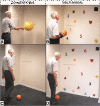Effects of conventional versus multimodal vestibular rehabilitation on functional capacity and balance control in older people with chronic dizziness from vestibular disorders: design of a randomized clinical trial
- PMID: 23276084
- PMCID: PMC3551791
- DOI: 10.1186/1745-6215-13-246
Effects of conventional versus multimodal vestibular rehabilitation on functional capacity and balance control in older people with chronic dizziness from vestibular disorders: design of a randomized clinical trial
Abstract
Background: There are several protocols designed to treat vestibular disorders that focus on habituation, substitution, adaptation, and compensation exercises. However, protocols that contemplate not only vestibular stimulation but also other components that are essential to the body balance control in older people are rare. This study aims to compare the effectiveness of two vestibular rehabilitation protocols (conventional versus multimodal) on the functional capacity and body balance control of older people with chronic dizziness due to vestibular disorders.
Methods/design: A randomized, single-blind, controlled clinical trial with a 3 months follow-up period will be performed. The sample will be composed of older individuals with a clinical diagnosis of chronic dizziness resulting from vestibular disorders. The subjects will be evaluated at baseline, post-treatment and follow-up. Primary outcomes will be determined in accordance with the Dizziness Handicap Inventory (functional capacity) and the Dynamic Gait Index (body balance). Secondary outcomes include dizziness features, functional records, body balance control tests, and psychological information. The older individuals (minimum sample n = 68) will be randomized to either the conventional or multimodal Cawthorne&Cooksey protocols. The protocols will be performed during individual 50-minute sessions, twice a week, for 2 months (a total of 16 sessions). The outcomes of both protocols will be compared according to the intention-to-treat analysis.
Discussion: Vestibular rehabilitation through the Cawthorne&Cooksey protocol has already proved to be effective. However, the addition of other components related to body balance control has been proposed to improve the rehabilitation of older people with chronic dizziness from vestibular disorders.
Trial registration: ACTRN12610000018011.
Figures
References
-
- Newman AB, Ferrucci L. Call for papers: aging versus disease. J Gerontol A Biol Sci Med Sci. 2009;64:1163–1164. - PubMed
-
- Tinetti ME, Williams CS, Gill TM. Dizziness among older adults: a possible geriatric syndrome. Ann Intern Med. 2000;132:337–344. - PubMed
-
- Sloane PD, Coeytaux RR, Beck RS, Dallara J. Dizziness: state of the science. Ann Intern Med. 2001;134:823–832. - PubMed
-
- Mira E. Improving the quality of life in patients with vestibular disorders: the role of medical treatments and physical rehabilitation. Int J Clin Pract. 2008;62:109–114. - PubMed
Publication types
MeSH terms
LinkOut - more resources
Full Text Sources
Medical



